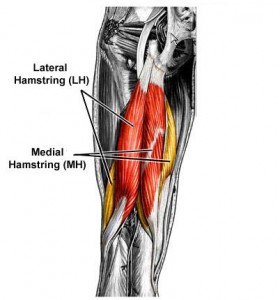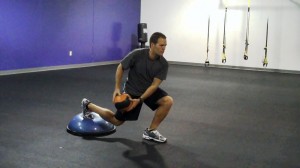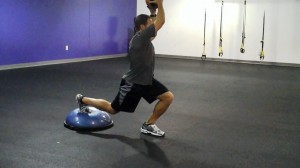Brian Schiff’s Blog
Injury Prevention, Sports Rehab & Performance Training Expert
Often, people assume hip and knee pain begin and end in those respective joints. While this can be the case, the truth is the ankle may also have a say in the matter. In my practice, I often see gait deviations, IT band issues, patellofemoral pain and many other issues related to ankle stiffness or soleus issues.
In assessing athletes, runners and weekend warriors, I often pick up asymmetries when measuring closed chain ankle dorsiflexion. I have even observed people who have active dorsiflexion within normal limits while seated on a treatment table, but once they become weight bearing things change. Even small differences can dramatically affect the body as the brain will find a way to get the motion it needs to squat, run, lunge, etc.
This often involves a compensatory pattern at the knee and/or hip joint. So, to that end, I recommend several strategies to improve mobility. I am currently doing a three part series on this for PFP magazine to provide some effective exercises to improve ankle and soleus mobility. Click here to read the latest column.
Below is a sample video of the wall touches I use to improve ankle motion after mobilizing the soft tissue.
Typically, I advocate doing 1-2 sets 10-15 repetitions. Using the wall allows clients to have tactile feedback and a target to focus on. This is a simple, yet effective way to gain motion in a loaded closed chain fashion as the hip, knee and ankle flex together in running, landing, squatting, lunging, etc.
If you are curious how I assess side-to-side differences, click here to read my initial column on assessment. I hope these tools enhance your training and/or those you work with.
So, I have been swamped with work and marathon training, hence the recent delay in a new blog post. Well, yesterday during a short 3 mile run (I am in taper mode with a 10/17 event) I experienced an acute left hamstring strain.
Hamstring strains are common and can produce incredible pain and limit function. Most hamstring strains occur as the swing leg is coming forward and the knee is nearing full extension. Essentially, it is a stretch type injury as the hamstring works to decelerate the momentum of the lower leg.
Injuries may be casued by inadequate warm-up, a sudden increase i training intensity/volume, fatigue, stiffness, weakness or muscle imbalances. A prior injury may also increase your risk for re-injury.

I have been running for years and am 5 months into my marathon training, so why now? I honestly think it may be related to my speed yesterday. My body naturally leans toward a 7:25 pace, but when I looked down at my Garmin yesterday at the point of pain, it said 6:54. Yikes! I was 1.25 miles into the short run.
I decided to keep running and slow my pace back to 7:30. While I was able to complete the run, my lower hamstring was very tight and sore after the run. Obviously, I have been icing regularly the last 24 hours. No running today either. I anticipate a quick recovery since the strain is mild and I am very fit. But, what is the best way to prevent re-injury?
I have a quick article summary from the Journal of Sports & Orthopedic Physical therapy Journal for you to read that underscores how important functional movement rehab is in comparison to just static stretching and strengthening.
Click here to read the summary of the journal article
Now, with respect to running, agility may not be necessary. Running is fairly linear (straight line) so what may be more important to gage capacity to return to running may be some of the following:
- Absence of pain with active knee straightening
- Absence of pain with walking
- No pain with single leg hopping
- Minimal to no muscle belly tenderness
In the end, you will need to let pain guide you. Some will return faster than others, but inside of 21 days (the end of the subacute healing phase) you must be aware of the fragility of the tissue as it heals. I am confident this will not derail my marathon, but the lesson learned is to watch your starting pace as it may lead to some muscle strain.
The longer I work with clients, the more hip issues I see. Generally speaking, I find the major issues to be related to decreased mobility, poor stability and muscle imbalances. These may occur in isolation or combination.
It is a no-brainer that most people have tight hip flexors and external rotators given all the sitting that takes place in our computer age. This inherently creates weakness and tightness. I feel that a natural propensity to be positioned in hip external rotation may actually reduce the firing of these muscles which in turn allows for more valgus moments at the knee and reduces lower limb stability.
Typically, female athletes fail to adequately fire the gluteus maximus (hip extension and external rotation) and prefer to dominate movement with the quads. So, how do we begin to change this?
Well, first we must focus on better hip mobility. I believe we must work to gain better hip extension by stretching the hip flexor group. I also believe we need to do this dynamically and not just passively. A dynamic approach also allows us to improve knee stability on the opposite side as we work on hip mobility. It will also allow us to resist internal rotation of the femur and the valgus moment at the forward knee.
Look at the images below:


I am demonstrating a BOSU split squat diagonal chop. This is the first of a series of BOSU exercises I am doing for PFP Magazine. The upward chop forces hip extension on the right side and the downward motion reinforces firing of the left glutes to reduce internal rotation and valgus. What a perfect combo right?
To read more about this exercise, click here.
Now, you should start on the floor with just the arms and progress from there. This is a great prehab exercise or warm-up activity, but it cna also be used for strengthening too. I hope you find it as beneficial in your routine as I do.
It is no secret that the average male gym goer loves to do plenty of bench press exercises. I was out at a piano bar last weekend celebrating the 10 year wedding anniversary of some close friends and witnessed the “bar body” syndrome firsthand.
For those not familiar with this lingo, the “bar body” belongs to the guy who overworks the chest and biceps, while typically neglecting the back leg muscles altogether. They routinely sport tight t-shirts and jeans even in the dead of summer in Ohio.
I spotted the bouncer right away. He was likely 25 years old and obviously proud of his caveman posture and large stature. What he does not know is that in 5-15 more years he will likely suffer significant shoulder impingement and AC joint arthritis, not to mention he will have little to no upper body flexibility.

Know anyone that fits this description? Look around in your local health club and you will surely find them. So, the takeaway messages are:
- Perform back to chest strengthening exercises in a ratio of 3:2 or even 2:1 to promote balance and better posture
- You do not need to bench press all the time (once per week is sufficient and may even be too much for some)
- You should do routine flexibility exercises for the chest as these muscles are tight in most of the population and they can contribute to increased internal rotation of the shoulders and rotator cuff problems
In light of this, I want to share a few effective exercises from my brand new Training & Sports Medicine Update Newsletter. To view these exercises, click HERE.
If you enjoyed this information, you can get even more info on exercise, recent research, sports performance training, injury prevention and rehab delivered to your inbox monthly by signing up for a subscription to my newsletter. You can grab the digital version for just $9.95/month. By subscribing, you are become eligible for immediate product discounts and promotional pricing on all new items.
Click here to sign up and get the entire first issue today!
In health,
Brian

